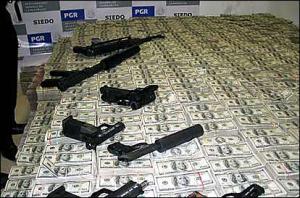by Bernd Debusmann, Jr.
Mexican drug trafficking organizations make billions each year smuggling drugs into the United States, profiting enormously from the prohibitionist drug policies of the US government. Since Mexican president Felipe Calderon took office in December 2006 and called the armed forces into the fight against the so-called cartels, prohibition-related violence has killed more than 36,000 people, including more than 15,000 last year. The increasing militarization of the drug war and the arrest or killing of dozens of high-profile drug traffickers have failed to stem the flow of drugs -- or the violence -- whatsoever. The Merida initiative, which provides $1.4 billion over three years for the US to assist the Mexican government with training, equipment and intelligence, has so far failed to make a difference. Here are a few of the latest developments in Mexico's drug war:

In the Monterrey suburb of San Nicolas de los Garza, Mexican marines arrested seven municipal police officers for their suspected ties to organized crime groups in the city. Local police in San Nicolas de los Garza and the neighboring suburb of Santa Catarina (where one of the officers was arrested) are thought by many local residents to be thoroughly compromised and infiltrated by drug cartels.
Thursday, March 24
In Tamaulipas, 13 gunmen were killed during a fire fight with an army patrol. The clash occurred after the patrol came under fire from a group of armed men on a highway between Valle Hermoso and Reynosa. One suspect was captured and vehicles and weapons were seized. It is unclear to which cartel the gunmen belong, although it is very likely they were Zetas.
In Mexico City, Mexico’s main television networks and news organizations agreed to put tighter controls on the often graphic images of victims of Mexico's drug war.
Friday, March 25
In Geneva, the International Displacement Monitoring Centre released a report which suggests that as many as 230,000 people have been displaced by drug-related violence in Mexico. About half of the displaced fled to the United States. Most of the internally displaced come from the states of Chihuahua, Coahuila, Durango and Veracruz.
In Monterrey, the body of the host of a TV shot for children was found in an abandoned Mercedes-Benz after having been kidnapped and executed by masked gunmen. The body of Jose Luis Cerda, "La Gata," was left with a note accusing him of supporting the Zetas. Eight police officers have been suspended after ordering journalists (who were broadcasting live) away from the scene upon receiving reports that armed men were on their way to retrieve the body.
Saturday, March 26
In Acapulco, five men – including four confirmed police officers - were killed and dismembered. A note, allegedly signed by members of the Sinaloa Cartel, was left alongside the bodies. The note accused the member of being supporters of CIDA, the Independent Cartel of Acapulco. The incident took place within hours of President Calderon inaugurating the 36th edition of the tourist marketplace at Acapulco’s international center.
On the Nuevo Laredo-Monterrey highway, a tractor-trailer exploded during a gun battle between gunmen and soldiers who were attempting to search the trailer. Three gunmen were killed in the incident. After the flames were extinguished, soldiers found a massive cache of weapons, including an RPG launcher, 16 40 mm. grenades, .50 caliber rounds, 31 rifles, 9 handguns and a fragmentation grenade. Cash was also found, in addition to an unspecified quantity of cocaine and meth.
Sunday, March 27
On the highway between Nuevo Laredo and Monterrey, motorists alerted police to the presence of seven dead men which had been shot execution-style and left by the highway. It is unclear who they are or why they were killed. The bodies were found near to Saturday's incident in which three gunmen were killed during an encounter with the army on the highway.
In Nuevo Laredo, four gunmen were killed during a fire fight with soldiers who came under fire while on patrol.
In Veracruz, five people were killed and at least a dozen were injured during a 90-minute fire fight between suspected Zetas and the army and a subsequent stampede of people outside a local bar. The incident began when soldiers began chasing a convoy of luxury SUVs which were protecting a heavily-armed, armored Hummer, thought to belong to a high-ranking Zeta commander. Up to 80 cartel gunmen were reported seen at the bar, a known hangout for traffickers. Details are still sketchy, but it appears that at least four soldiers were also killed in the incident. At one point, cartel reinforcements arrived in a successful effort to facilitate the escape of the high-ranking Zeta in the Hummer, who remains unidentified.
Monday, March 28
In Cuernavaca, police discovered seven bodies inside an abandoned car in an exclusive gated community, four of them stuffed in the trunk. One of the dead was a woman.
In Apatzingan, Michoacan, two men were executed. A sign left with the bodies claimed the were killed by the Knights Templar, which is thought to be a successor or offshoot organization to the weakened Familia Michoacana.
[Editor's Note: We typically rely on El Universal to supply a weekly body count. They didn't provide one this week, so this week's figure is based only on our own research and may be revised upward.]
Total Body Count for the Week: 106
Total Body Count for the Year: 1,767
Total Body Count for 2010: 15,273
Total Body Count for 2009: (approx.) 9,600
Total Body Count for 2008 (approx.): 5,400
Total Body Count for 2007 (approx): 4,300
Total Body Count for Calderon's drug war through 2010: 34,849
Total Body Count for Calderon's drug war to date: 36,616
This work by StoptheDrugWar.org is licensed under Creative Commons Attribution-ShareAlike 4.0 International
Comments
yo sup guys. i am researching
yo sup guys. i am researching this for project at school. cool111!.
drug?S1!
gogogo fight drug add oil! jia you! i love to fight! errrr!11!
Add new comment